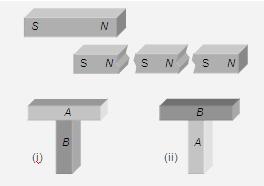Theory of Magnetism
The molecular theory of magnetism was given by Weber and modified later by Ewing. According to this theory -
Every molecule of a substance is a complete magnet in itself. However, in an magnetised substance the molecular magnets are randomly oriented to give zero net magnetic moment. On magnetising, the molecular magnets are realigned in a specific direction leading to a net magnetic moment.

BAR MAGNET: A bar magnet consist of two equal and opposite magnetic pole separated by a small distance. Poles are not exactly at the ends. The shortest distance between two poles is called effective length (Le) and is less than its geometric length (Lg).
(1) Directive properties: When a magnet suspended freely it stays in the earth's N-S direction (in magnetic meridian).

(2) Monopoles concept: If a magnet is Broken into number of pieces, each piece becomes a magnet. This in turn implies that monopoles do not exist. (i.e., ultimate individual unit of magnetism in any magnet is called dipole).

(3) For two rods as shown, if both the rods attract in case (i) and doesn't attract in case (ii) then, B is a magnetic and A is simple iron rod. Repulsion is sure test of magnetism.
(4) Pole strength (m) : The strength of a magnetic pole to attract magnetic materials towards itself is known as pole strength.
(i) It is a scalar quantity.
(ii) Pole strength of N and S pole of a magnet is conventionally represented by +m and -m respectively.
(iii) It's SI unit is amp × m or N/Tesla and dimensions are [LA].
(iv) Pole strength of the magnet depends on the nature of material of magnet and area of cross section. It doesn't depends upon length.

(5) Magnetic moment or magnetic dipole moment (M->): It represents the strength of magnet. Mathematically it is defined as the product of the strength of either pole and effective length. i.e. M-> = m(2l->)
(i) It is a vector quantity directed from south to north.

(ii) It's S.I. unit amp×m2 or N-m/Tesla and dimensions [AL2]
Various Terms Related to Magnetism
(1) Magnetic field and magnetic lines of force : Space around a magnetic pole or magnet or current carrying wire within which it's effect can be experienced is defined magnetic field. Magnetic field can be represented with the help of a set of lines or curves called magnetic lines of force.

(2) Magnetic flux (f) and flux density (B)
(i) The number of magnetic lines of force passing normally through a surface is defined as magnetic flux (f). It's S.I. unit is weber (wb) and CGS unit is Maxwell.
Remeber 1 wb = 108 maxwell.
(ii) When a piece of a magnetic substance is placed in an external magnetic field the substance becomes magnetised. The number of magnetic lines of induction inside a magnetised substance crossing unit area normal to their direction is called magnetic induction or magnetic flux density (B->) It is a vector quantity.

It's SI unit is Tesla which is equal to wb/m2 = N/(amp x m) = J/(amp x m2) = (volt x sec)/m2
and CGS unit is Gauss. Remember 1 Tesla = 104 Gauss.
(3) Magnetic permeability: It is the degree or extent to which magnetic lines of force can enter a substance and is denoted by μ. OR
Characteristic of a medium which allows magnetic flux to pass through it is called it's permeability. e.g. permeability of soft iron is 1000 times greater than that of air.

Also μ = μ0μr where μ0 absolute permeability of air or free space = 4π x 10-7 tesla x m/amp.
and μr Relative permeability of the medium = B/B0 = flux density in material/flux density in vacuum
(4) Intensity of magnetising field (H) (magnetising field): It is the degree or extent to which a magnetic field can magnetise a substance. Also H = B/μ.
It's SI unit is A/m = N/(m2 x Tesla) = N/wb = J/(m3 x Tesla) = J/(m x wb)It's CGS unit is Oersted. Also 1oersted = 80 A/m
(5) Intensity of magnetisation (I) : It is the degree to which a substance is magnetised when placed in a magnetic field.
It can also be defined as the pole strength per unit cross sectional area of the substance or the induced dipole moment per unit volume.
Hence I= m/A = M/V It is a vector quantity, it's S.I. unit is Amp/m.
(6) Magnetic susceptibility (cm) : It is the property of the substance which shows how easily a substance can be magnetised. It can also be defined as the ratio of intensity of magnetisation (I) in a substance to the magnetic intensity (H) applied to the substance, i.e. Χm = I/H. It is a scalar quantity with no units and dimensions.
(7) Relation between permeability and susceptibility : Total magnetic flux density B in a material is the sum of magnetic flux density in vacuum B0 produced by magnetising force and magnetic flux density due to magnetisation of material Bm. i.e. B = B0 + Bm
B = μ0H + μ0l = μ0 (H + l) = μ0H(1 + Xm) Also μr = (1 + Xm)
